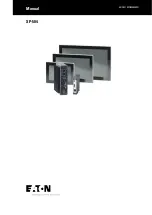
Introduction
10
DigiTrak
®
F5
®
SST
®
Operator’s Manual
There are some important terms and procedures that are used specifically with the SST system that you
should understand. These include the following:
Heading
– Azimuth compass heading or direction measured by the SST transmitter with respect
to the
Earth’s North Pole. (Known as Yaw in the Eclipse steering tool system.)
Reference heading
– Azimuth heading of the SST transmitter measured when it is accurately
positioned on the surveyed bore path prior to the start of the drill run. The course deviation is
determined from this heading. The value for the reference heading is determined at the start of
the SST operating procedure. (Known as reference yaw or Ref Yaw in the Eclipse steering tool
system.)
Shoot the probe
– Term commonly used for the procedure of measuring the reference heading
using the SST transmitter (probe).
360° roll
– Standard HDD walkover systems use a “clock” roll orientation. The SST transmitter
uses a 360° roll sensor with 1° increments,
where 0° = 12 o’clock, 90° = 3 o’clock, 180° =
6
o’clock, and 270° = 9 o’clock.
The following types of data are displayed and recorded with the SST guidance system:
Heading (in tenths of a degree)
– Displayed on receiver and remote and recorded on computer.
Reference heading (in tenths of a degree)
– Displayed on remote and recorded on computer.
Heading deviation (in tenths of a degree)
– Amount of deviation SST transmitter is exhibiting from
the reference heading; displayed on remote and recorded on computer.
Depth (in feet or meters), pitch (in tenths of a percent or tenths of a degree), and roll (in degrees
from 0
–360°) – Displayed on receiver and remote when receiver is used for walkover locating;
calculated depth is displayed and recorded on computer.
Course deviation (in feet/meters)
– Displayed and recorded on computer.
Temperature (in degrees Fahrenheit or Celsius)
– Displayed on receiver and remote; not
recorded on computer.
Voltage levels for power supply and SST transmitter (in volts)
– Displayed on remote; not
recorded on computer.
System current (in amps)
– Displayed on remote; not recorded on computer.
Distance from drill rig and bore distance (in feet/meters)
– Displayed and recorded on computer
only.
Date and time of recording
– Displayed and recorded on computer only.
To further expedite wireline connection time, the SST system can be used with the DigiTrak CableLink
connection system. The CableLink system is preinstalled in drill rods so that the electrical connection is
made when the rods are threaded up.
This operator’s manual begins by describing the primary
System Components
—including the SST
transmitter, the F5 SST receiver, the SST remote display, the multi-function cable box (MFCB), and the
laptop computer with preinstalled LWD (Log-While-Drilling) software
—and the other supplies needed for











































